flight of CODLING MOTH (Entfact 202) and ORIENTAL FRUIT MOTH (203);
treatment time for HOLLY LEAFMINERS;
WIREWORMS (120) and SEED MAGGOTS (133) causing stand reduction in field crops.


ASPARAGUS beetles feeding and laying eggs;
flight of CODLING MOTH (Entfact 202) and ORIENTAL FRUIT MOTH (203);
treatment time for HOLLY LEAFMINERS;
WIREWORMS (120) and SEED MAGGOTS (133) causing stand reduction in field crops.


 Black shank is by far the most destructive disease of burley tobacco in Kentucky, surpassing blue
mold in importance if we look at annual losses. A fungus-like organism,
Phyophthora parasitica var. nicotianae (PPN), is the causal agent of black shank. The pathogen is widespread in Kentucky, and throughout the southeastern United States.
Black shank is by far the most destructive disease of burley tobacco in Kentucky, surpassing blue
mold in importance if we look at annual losses. A fungus-like organism,
Phyophthora parasitica var. nicotianae (PPN), is the causal agent of black shank. The pathogen is widespread in Kentucky, and throughout the southeastern United States.
Symptoms of black shank can appear on all parts of the tobacco plant; however, the root and basal stem are the most commonly affected areas. Plant age and environment affect expression of symptoms. In young seedlings, the stem near the soil line will darken and the plant will eventually die (damping-off). Seedlings are more commonly infected in traditional plant beds, but black shank has also been documented in float beds. In older plants, the first symptom is usually wilting, particularly during the hottest part of the day. Rapid yellowing occurs followed by death of the infected plant. A dark lesion is often present at the soil line and may extend several inches up the side of the stalk, hence the name "black shank". Splitting an infected stalk will reveal darkened pith material that has separated into discrete disks. The root and crown of the plant may also be necrotic.
Warm weather (84-90 °F) and wet conditions are ideal for the development and spread of black shank. Initial infections are caused by PPN that has overwintered on crop debris or in soil as mycelia or chlamydospores (thick-walled resting structures). Motile zoospores produced by PPN are the principal means of spread from infected plants to healthy ones (secondary spread). The black shank pathogen is an Oomycete, or water mold, and zoospores need free water in which to swim. Zoospores are liberated from sporangia; new sporangia and chlamydospores are produced on infected tissues within 48 hours of the initial infection. The potential for spread within a field is tremendous under ideal conditions. Chlamydospores can survive for several years in the absence of tobacco, making it difficult to eradicate PPN from a field once it has become established.
Black shank is spread within and between fields in water. Runoff after rain can move PPN down rows, while creeks and ponds serve as reservoirs of inoculum that can infest fields if used as irrigation sources. The pathogen can also be spread between fields by movement of infested soil on equipment and on feet. Infected tobacco stalks also harbor the pathogen and can spread PPN to non-infested fields if disposed of improperly. Disease development is optimal at a soil pH of 6-7, and suppressed to some degree in acid soils.
Once established in a field, PPN cannot be eliminated and black shank will always be a threat in contaminated sites. Control of black shank requires an integrated approach of several tactics:
Rotation. This is the cornerstone of any black shank management program. The black shank pathogen survives and reproduces mainly on tobacco. Rotation away from tobacco for a year will significantly reduce primary inoculum; however, rotations of 3-5 years have been shown to reduce populations of PPN to the greatest degree. Just about any crop will serve as a good rotation partner with tobacco, although grass sods seem to promote degradation of pathogens populations to a greater degree than other crops.
Resistance. Tobacco varieties with varying degrees of resistance to black shank are available. We have two races of PPN in Kentucky, Race 0 (the most common) and Race 1. No variety is immune to black shank, and burley varieties with high levels of resistance to both races of PPN are not available (unlike flue-cured varieties). Growers of dark tobacco will find that resistance to black shank is limited these varieties. The 2005 Guide to Burley Tobacco Varieties (http://www.uky.edu/Ag/TobaccoProd/pubs/varbull05.pdf) summarizes the levels of resistance to common burley varieties to both races of PPN. Resistance is scored on a 0-10 scale, where 10 represents the highest level of resistance to a given race of the pathogen. Keep in mind that PPN will reproduce on the roots of resistant varieties, so this tactic should be used in conjunction with other management practices to obtain the best control possible of black shank.
Chemicals. Chemical control options for black shank are few but can be an important part of a black shank management program. The most effective tool in Kentucky is mefenoxam, sold as Ridomil Gold EC or Ultra-Flourish. The materials can be applied pre-plant, and again at the first cultivation or at lay-by. See last week's KPN article for recommended rates. Soil fumigants are less commonly used in Kentucky, but can significantly reduce PPN populations where infestations are severe. Rates and application methods are summarized in last week's article as well.
Drainage. Adequately drained soils are less conducive to the development of black shank. Steps should be taken to eliminate areas that permit water to stand in fields.
Sanitation. Take all necessary steps to prevent the introduction of PPN into clean fields. Dispose of infected stalks at the end of each season (bury or incinerate). Sanitize feet and equipment when moving between fields. A number of sanitizing solutions are commercially available.
Avoidance. Don't irrigate float beds or fields with surface water if at all possible. Don't use surface water to set plants. Use quality transplants - preferable produced in-house.
Disease Control. Nematodes, a minor problem in Kentucky, and seedling diseases can predispose tobacco to infection by PPN. Controlling these problems can also aid in controlling black shank.
For the latest blue mold status and other tobacco disease information, check the KY Blue Mold Warning System online.
![]() http://www.uky.edu/Agriculture/kpn/kyblue/kyblue.htm
http://www.uky.edu/Agriculture/kpn/kyblue/kyblue.htm

For more information about tobacco pests, visit "Insect Management Recommendations".

 Sometimes application of a soil-applied herbicide is delayed due to weather conditions or other factors that prevent timely herbicide treatments at planting. In these situations the crop may have emerged before a soil residual herbicide could be applied. In other cases a soil-applied herbicide may be added to an early postemergence herbicide application to extend the residual weed control activity. The following list outlines the maximum corn and weed size labeled for use of various soil-applied herbicide products on field corn. Keep in mind that not all soil-applied herbicides can be applied after corn emergence. In fact, some products may cause significant crop injury if applied after crop emergence. Many of these soil-active herbicides do not control emerged weeds; therefore, to obtain effective weed control a herbicide with postemergence activity may also be needed. Consult the herbicide product for specific label guidelines, tank mixtures, precautions, or other limitations.
Sometimes application of a soil-applied herbicide is delayed due to weather conditions or other factors that prevent timely herbicide treatments at planting. In these situations the crop may have emerged before a soil residual herbicide could be applied. In other cases a soil-applied herbicide may be added to an early postemergence herbicide application to extend the residual weed control activity. The following list outlines the maximum corn and weed size labeled for use of various soil-applied herbicide products on field corn. Keep in mind that not all soil-applied herbicides can be applied after corn emergence. In fact, some products may cause significant crop injury if applied after crop emergence. Many of these soil-active herbicides do not control emerged weeds; therefore, to obtain effective weed control a herbicide with postemergence activity may also be needed. Consult the herbicide product for specific label guidelines, tank mixtures, precautions, or other limitations.
 There have been several reports of wireworms in corn in 2005 for a few central Kentucky counties. In some of the more severe fields, growers report for 5 to 10 percent stand reduction due to wireworms in addition to other problems. In some of these fields seed treatments and/or soil insecticides were used.
There have been several reports of wireworms in corn in 2005 for a few central Kentucky counties. In some of the more severe fields, growers report for 5 to 10 percent stand reduction due to wireworms in addition to other problems. In some of these fields seed treatments and/or soil insecticides were used.
If wireworm damage is suspected, growers should dig up the kernels in the skips in the rows to determine the cause of stand loss. A wireworm damaged kernel will appear hollowed out, at least a portion of it. In other cases the kernel may appear intact, but the coleoptile has been attacked before emergence from the soil.
Unfortunately, the cool temperatures in late April delayed emergence of the corn planted in early and mid April. The slow germination and growth of the seedlings exposes the developing plants for a greater period of time to damaging wireworm attack. Corn will be vulnerable to stand loss by wireworms until the plants attain a caliper size of a pencil or so. Once symptoms of damage begin to appear, there are no effective rescue treatments. If stand loss is severe, 25 to 30 percent loss or more, growers may want to consider replanting. Plants will be able to more rapidly pass through these vulnerable stages with the return of warm weather and more rapid seedling development.
 Cool weather with wet soils for sustained periods in springtime can promote seedling diseases of corn,
including seed decay, pre-emergence damping off and post-emergence damping off. Pythium species,
common soil-borne fungal-like organisms, are common causes of root decay in corn seedlings under
these soil conditions.
Cool weather with wet soils for sustained periods in springtime can promote seedling diseases of corn,
including seed decay, pre-emergence damping off and post-emergence damping off. Pythium species,
common soil-borne fungal-like organisms, are common causes of root decay in corn seedlings under
these soil conditions.
To my knowledge, all commercial corn seed is treated with metalaxyl/mefenoxam. These fungicides which are, for practical purposes, identical active ingredients provide 10-14 days of protection from infection by Pythium species. However, if growth of corn is slowed excessively, this protection may not be enough to protect the seedling. Fludioxonil fungicide, the active ingredient in Maxim , provides protection against Fusarium species, which may also be active. However, while both fungicides are systemic, they translocate upward in the plant towards the leaves and not downward towards the roots. Thus, several weeks of sustained cool, wet soils could leave seedlings vulnerable to infection.
Seedling root rots of corn are normally more damaging in corn that is under stress. In some circumstances, the unusually wet conditions may be enough to set a crop up for damage. In others, there may be additional factors that predispose the crop to damage from these diseases: improper herbicide application, seed of low vigor, etc. Also, since Pythium species are favored by saturated soil conditions, compacted soil horizons can increase disease pressure. If corn seedling root rots are observed, it would pay to evaluate the agronomics of the field to see if replanting is need. Information on assessing corn stands is available in the Extension publication Kentucky Integrated Crop Management Manual for Field Crops: Corn, IPM-2. For fields with stands that are poorer than expected, the chapter on "Planting Practices" in the publication A Comprehensive Guide to Corn Management in Kentucky, ID-139, provides producers with guidelines for determining whether or not replanting is likely to be advantageous.
For information about corn pests, visit
"Insect Management Recommendations".


Pea aphids and spittlebugs are sap feeders that thrive during cool, wet springs. The light green pea aphids can be found in clusters on plant stems and terminal buds. Use of an insecticide to control them might be justified if alfalfa foliage is yellow and wilting and there is an average of 50 to 75 aphids per stem. If many aphids are present, you may see bloated, straw-colored aphid mummies that have been parasitized by a tiny wasp. The wasps and hotter weather will reduce aphid numbers naturally.
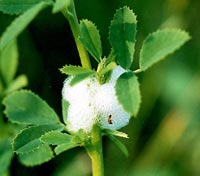 Spittlebugs overwinter as eggs inserted between the sheath and stem of grasses. They are most common in mixed grass and alfalfa stands. The nymphs, or immature stages, excrete a frothy liquid that covers them completely, providing protection from drying out and may provide some protection against natural enemies that prefer to look for food that isn't covered with spit.
Spittlebugs overwinter as eggs inserted between the sheath and stem of grasses. They are most common in mixed grass and alfalfa stands. The nymphs, or immature stages, excrete a frothy liquid that covers them completely, providing protection from drying out and may provide some protection against natural enemies that prefer to look for food that isn't covered with spit.
An average of one or more spittlebugs per stem is needed to justify concern. Even then, the spittle probably provides protection against and insecticide spray, reducing the effectiveness of any attempted control measure.
See Insect Recommendations
for more alfalfa pest recommendations.


Many Kentucky gardens feature iris plantings; these flowers are popular and well adapted. Frequent rains earlier this spring have favored several diseases. Leaf spot is just appearing and corm rot can be devastating to individual plants in some iris beds.
Iris leaf spots. The fungus Mycosphaerella macrospora, formerly known as Didymellina macrospora, causes the most prevalent leaf spot. On diseased leaves, oval spots with reddish-brown margins and gray centers appear anywhere on the leaf blade. Spots continue to appear and can become so numerous that leaves become blighted and die. In some years, iris beds are devastated by this fungus; the dead, tan and brown leaves remain upright making the disease a real eyesore in the garden. If the center of the gray spot is examined closely, dark fungal growth of Heterosporium iridis, the imperfect stage of the fungus, can be seen.
Bacterial leaf spot caused by Xanthomonas tardicrescens shows symptoms similar to those of the fungal leaf spot without the fungal growth in the center of the spot. Similar to the fungal leaf spot, bacterial spots may have a water-soaked appearance. This disease occurs less frequently in Kentucky, but can also cause blighting.
Rust disease results in rusty-red pustules appearing on either side of affected leaves. The fungus, Puccinia iridis, can cause considerable damage to several iris varieties. Iris rust is relatively uncommon in Kentucky.
To control leaf spot diseases, remove blighted leaves during the season, and remove and destroy all foliage in the fall. Fungicides containing chlorothalonil, mancozeb, myclobutanil, propiconazole, or triademefon can be used to protect iris from Didymellina leaf spot. Fungicides will not control bacterial leaf spot.
Iris rhizome and bulb disorders. Bacterial soft rot is a serious disease of the rhizome that can appear in newly planted as well as mature iris plantings. The pathogen, Erwinia carotovora causes a foul-smelling soft decay of the rhizome. The bacterium gains entrance into the plant through wounds in young leaves made by young larvae of the iris borer. Soft rot is prevented by planting healthy rhizomes and preventing iris borer infestations.
Botrytis convoluta and Sclerotium rolfsii are two fungi that can cause rhizome and crown rot diseases of iris. The former produces irregular black sclerotia in the decaying rhizome, while the latter produces small spherical sclerotia on the rotted leaf bases. Neither produces a foul-smelling decay. When affected rhizomes are found, they should be removed and destroyed.
Bulbous iris are subject to several bulb diseases and decays. Diseases such as black rot, ink spot, Fusarium basal rot, and blue mold cause decays of bulbous iris. Sort out and destroy diseased bulbs as they occur.
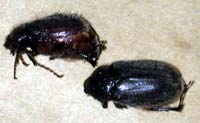 Oaks can be stripped of their leaves practically overnight by May beetles. Active soon, these beetles are approximately 1" long and cylindrical, color varies from brown to black.
Oaks can be stripped of their leaves practically overnight by May beetles. Active soon, these beetles are approximately 1" long and cylindrical, color varies from brown to black.
The species which attack oak feed at night, stripping the foliage and leaving only veins. Consequently, the damage is present but there is no sign of the cause. The beetles leave the trees during the day and may be found under leaves or grass around the tree. Sevin is very effective against these insects. The feeding period lasts for several days but one treatment should be sufficient.
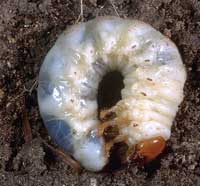 The larval stages are white grubs that feed on the roots of grasses. Large expanses of turf or pasture can produce thousands of these beetles. Fortunately, the beetles are around for only a short time and oaks will push out a new set of leaves.
The larval stages are white grubs that feed on the roots of grasses. Large expanses of turf or pasture can produce thousands of these beetles. Fortunately, the beetles are around for only a short time and oaks will push out a new set of leaves.
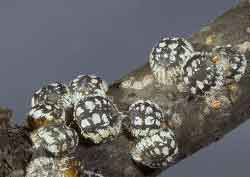 In recent years, calico scales have become rampant on several landscape plants, including honeylocust, hawthorn, hackberry, sweet gum, yellowwood, dogwood, flowering crabapple, and sugar and Norway maples. Infestations are so heavy in some cases that entire twigs and stems are covered by the scales and the trees are in decline.
In recent years, calico scales have become rampant on several landscape plants, including honeylocust, hawthorn, hackberry, sweet gum, yellowwood, dogwood, flowering crabapple, and sugar and Norway maples. Infestations are so heavy in some cases that entire twigs and stems are covered by the scales and the trees are in decline.
Mature calico scales, Eulecanium cerasorum, are large, black and white globular-looking insects about the size of a pencil eraser. They have a soft, leathery body and when crushed ooze a gummy, wax-like fluid. The immobile, adult female is the life stage observed during the spring, attached to twigs and stems. Some people mistake them for ladybugs, which are roughly the same size. Like other scale insects, the calico scale feeds by sucking plant juices. Heavy infestations can cause premature leaf drop, branch dieback and, coupled with other stresses, eventual tree death. During April and May, females excrete copious amounts of honeydew (essentially sugar-rich diarrhea!) that coats the leaves and anything beneath infested trees with a sticky glaze. The honeydew and resultant black sooty mold are cosmetically unappealing and can stain patios and car finishes, and attract wasps and other nuisance pests.
The mature females are now dying. Underneath them are thousands of eggs which have begun hatching into crawlers. The crawler stage moves to the leaves where it sucks plant juices, returning to the bark in autumn, before leaf fall, to overwinter. Another reason to take action against the crawlers is that they can become wind borne, spreading the infestation to other trees nearby.
Management
It's too late to impact the mature females, which turn brown and die just before crawler hatch. However, the underlying eggs soon will hatch (i.e., around May 20, and the crawlers will be settling on the leaves. Crawler hatch begins, on average, at about 1475 accumulated degree days (calculated from January 1 using a base temperature of 40ºC). The yellowish, newly-hatched crawlers are tiny, but under close inspection their movement will be visible to the naked eye.
Insecticide applications, timed to coincide with emergence of young crawlers, will break the cycle of development and help alleviate further plant stress. Ideal treatment timing is when about 75% of the globular adult females have turned brown. The most effective insecticides for crawler control are synthetic pyrethroids such as TalstarOne, Tempo (= Bayer Advanced Lawn & Garden Multi Insect Killer), and Scimitar (= Spectracide Triazicide). Sevin also can be used. Thorough coverage of infested twigs, branches and adjoining leaves is important. The hatching period lasts several weeks so a second application 2 to 3 weeks after the first may provide more complete control. Horticultural oil, insecticidal soaps, and tree injections have not been very effective against this scale insect species.


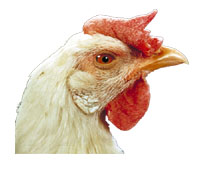 The northern fowl mite is a common and important external parasite of poultry and wild birds, such as sparrows and starlings. In commercial and home flocks, large numbers of these blood-sucking mites can produce anemia, reduce egg production, or general thriftiness of the birds, and greatly stress them. In addition, the mites will bite humans and produce significant skin irritation or dermatitis.
The northern fowl mite is a common and important external parasite of poultry and wild birds, such as sparrows and starlings. In commercial and home flocks, large numbers of these blood-sucking mites can produce anemia, reduce egg production, or general thriftiness of the birds, and greatly stress them. In addition, the mites will bite humans and produce significant skin irritation or dermatitis.
The life cycle takes place entirely on the bird with the mites concentrated around the vent (anal) area. Under favorable conditions, development from egg to adult can take only 5 12 days so large numbers can build up rapidly in a flock. The mites do best in a temperature range of 65 F to 68 F so numbers peak at cooler times during the year.
Initially light infestations of the mite can explode into very heavy infestations (20,000 mites per bird) in 8 to 10 weeks. Once a bird is moderately infested, the mites can spread within the flock, primarily by bird to bird contact. However, the mites can live off of the host for 2 to 3 weeks. They can be moved on egg crates, flats, egg collectors, or even rats living around the chicken house.
Control of northern fowl mite infestations requires thorough treatment using a high pressure sprayer to deliver about 6 fl oz of finished spray to each bird. The vent area must be thoroughly wetted to the skin to kill the mites. Compressed air (pump up) sprayers generally do not do an adequate job of forcing the spray into the feathers.
Two factors affect mite control. First, eggs laid on the birds are not killed by the insecticides. This serves as a continuous reinfestation threat. Second, some birds are not treated thoroughly. They cluster during spraying and can screen each other to block good spray deposit. Small numbers of surviving mites on these birds can act as a reservoir to re-infest the flock. A second application, 4 to 7 days after the first, will help to control escapees or newly hatched mites. Check the insecticide label for re-treatment intervals.
Northern fowl mite infestations can begin in several ways-
1) Wild birds entering the chicken house or nesting in and around it can be a source. Nestling birds can have high mite loads. Mites left behind when these birds leave the nest can wander off to find a new host. Screen out wild birds to reduce chances of mite introduction.
2) Consider any birds entering the flock to be infested. Treat them preventively before release. Ideally, they should receive two applications before mixing with the flock. Roosters can carry larger mite populations than hens and the mites on them can be much more widely distributed on the body, also. Inspect and treat roosters that are used to "spike" breeding flocks.
3) Regularly insect a portion of birds in the flock for mites. This will help to detect infestations early and allow for a treatment before a general spread throughout the flock
For more information livestock pests, visit "Insect Management Recommendations".


UKREC-Princeton, KY, April 3 - May 6, 2005 | Black Cutworm
| 3
| True Armyworm
| 7
| Corn Earworm
| 0
| European Corn Borer
| 0
| | |
Hardin County, KY, April 3 - May 6, 2005 | Black Cutworm
| 1
| True Armyworm
| 1
| | |
For information on trap counts in southern Illinois visit the Hines Report at - http://www.ipm.uiuc.edu/pubs/hines_report/comments.html The Hines Report is posted weekly by Ron Hines, Senior Research Specialist, at the University of Illinois Dixon Springs Agricultural Center.

NOTE: Trade names are used to simplify the information presented in this newsletter. No endorsement by the Cooperative Extension Service is intended, nor is criticism implied of similar products that are not named.
Lee Townsend
Extension Entomologist